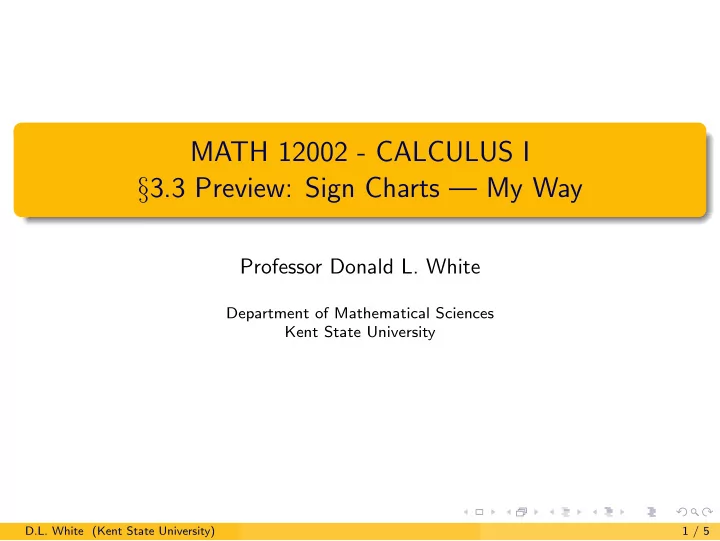

MATH 12002 - CALCULUS I § 3.3 Preview: Sign Charts — My Way Professor Donald L. White Department of Mathematical Sciences Kent State University D.L. White (Kent State University) 1 / 5
Signs and Sign Charts To determine the sign of a function g ( x ), we use the following basic facts: 1 If a function is continuous everywhere it is defined, then it can change sign only where it is either 0 or undefined. Thus, on the interval between two such points, the sign of the function is constant. 2 A quotient of two functions (for example, a rational function) is 0 where the numerator is 0 (and the denominator is not) and is undefined where the denominator is 0. Therefore, given a function g ( x ), we need to determine where it is 0 or undefined, and then determine the sign of g ( x ) on the intervals with these points as endpoints. There are two standard ways to determine the sign of a function on the interval between two zeros or undefined points: One way is to evaluate the function at some number in the interval. All of the function values on the interval will have the same sign as that y value. This method is a lot of work, even with a calculator, and I rarely use it. D.L. White (Kent State University) 2 / 5
Signs and Sign Charts The other method is to use a sign chart with the signs of the factors. This method is based on the following: 1 A linear factor, ax + b , will be zero at one point ( x = − b a ) and will be positive on one side of the zero and negative on the other. 2 Signs “multiply” and “divide” as follows: + + · + = + + = + + + · − = − − = − − − · + = − + = − − − · − = + − = + 3 A product/quotient of an even number of negative factors is positive. A product/quotient of an odd number of negative factors is negative. D.L. White (Kent State University) 3 / 5
Example Example x 3 +2 x 2 Determine the intervals where the function g ( x ) = − x 2 +3 x − 2 is positive and the intervals where it is negative. Solution First notice that x 2 ( x + 2) g ( x ) = ( x − 2)(1 − x ) . Therefore, g ( x ) = 0 at x = − 2 and at x = 0 , and g ( x ) is undefined at x = 1 and x = 2 . The sign of g is constant on each of the intervals ( −∞ , − 2) , ( − 2 , 0) , (0 , 1) , (1 , 2) , (2 , ∞ ) . We begin our sign chart with a number line with these x values in order: − 2 0 1 2 [Continued → ] D.L. White (Kent State University) 4 / 5
Example Solution [continued] x 2 ( x + 2) g ( x ) = ( x − 2)(1 − x ) : − 2 0 1 2 x 2 + + + + + 0 x + 2 − + + + + 0 x − 2 + − − − − 0 1 − x + + + − − 0 g ( x ) + − − + − 0 0 X X Therefore, g ( x ) is positive on ( −∞ , − 2) ∪ (1 , 2) and g ( x ) is negative on ( − 2 , 0) ∪ (0 , 1) ∪ (2 , ∞ ) . D.L. White (Kent State University) 5 / 5
Recommend
More recommend